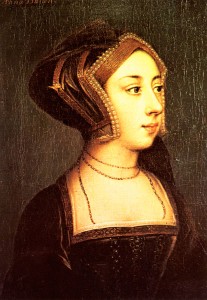 On 26th August 1533, Queen Anne Boleyn took to her chamber to prepare for the birth of her first child, the future Elizabeth I.
On 26th August 1533, Queen Anne Boleyn took to her chamber to prepare for the birth of her first child, the future Elizabeth I.
Anne’s “taking her chamber” ceremony took place at Greenwich Palace. A heavily pregnant Queen Anne Boleyn attended a special mass at the palace’s Chapel Royal and then processed with her ladies to the Queen’s great chamber. There, the group enjoyed wine and spices before Anne’s lord chamberlain prayed that God would give the Queen a safe delivery. After the prayer, Anne and her ladies retired to her chamber, which, from that moment on, would be a male-free zone.
A woman usually took to her chamber four to six weeks before her due date and for royal women it was preceded by a special church service, as was the case with Anne Boleyn. In the Ordinances by Margaret, Countess of Richmond and Derby, as to what Preparation is to be made against the Deliverance of a Queen, as also for the Christening of the Child which she shall be delivered, a manual written by Margaret Beaufort, Henry VII’s mother, in 1486 when Elizabeth of York, her daughter-in-law, was expecting her first child, Margaret set out in detail the preparations to be made for the Queen’s confinement, down to minuscule details. She also went on to give instructions as to how the church should be “arrayed” for the Christening service and what the child would need in his/her nursery.
In her ordinances, Margaret gave detailed instructions on how the Queen’s chamber was to be prepared and furnished for her lying-in. Preparations included:
- The hanging of rich cloth of arras (tapestries) on the walls, ceiling, windows and all.
- One window being hanged loosely so that light could be let in when it pleased the Queen.
- A royal bed set up along with a pallet or day-bed, with these beds also being hanged to match the rest of the room.
- The floor to be covered with carpets.
- A cupboard to be covered with arras.
The church where the Queen was to receive mass was also to be “well and wonderfully arrayed” and the Great Chamber outside the Queen’s chamber was to be hanged with rich arras, fully carpeted, and set out with a cloth and chair of Estate, along with cushions. The Great Chamber was where the Queen would receive spices and wine on her return from the chapel and before going into her chamber. The chamber between the Great Chamber and the Queen’s chamber was also to be “well and worshipfully hanged”.
After enjoying the refreshments, the Queen was to be led to her chamber by two of the greatest estates, that is to say the highest peers of the realm, who would leave her at the door. The Queen’s chamber was to be a women-only environment with women acting as butlers, sewers etc. Any male officers who needed to bring things to the Queen would be received by the Queen’s women in the Great Chamber.
The Ordinances even go into detail on how much fabric, and what type of fabric, was to be used to furnish the Queen’s bed, for example two pairs of sheets of “reines” were to be “4 yardes broade, and 5 yardes longe”. The bedding included fustian pillow stuffed with fine down, a pane of scarlet furred with ermine and embroidered with crimson velvet on velvet or cloth of Gold. There was to be a mattress fluffed with wool, a feather bed and bolster of down, a “sparner” embroidered with crowns of gold, the king’s and queen’s arms and device, lined with double tarterton, garnished with fringes of silk, blue russet and gold. There was also to be a bowl of gold or silver and gilt, 4 cushions of crimson damask cloth of gold, a round mantel of crimson velvet furred throughout with ermine.
The pallet was to be arrayed in a similar way to the bed.
Margaret also instructed that those of high estate who had been chosen by the King to go to the christening should “be placed near to the place where the Queen is delivered” so that they would be ready for the christening.
Notes and Sources
This text is based on a video talk I did for the Tudor Society in March 2015 on Margaret Beaufort’s Ordinances – https://www.tudorsociety.com/margaret-beauforts-ordinances-video/.
- Ordinances by Margaret, Countess of Richmond and Derby, as to what Preparation is to be made against the Deliverance of a Queen, as also for the Christening of the Child which she shall be delivered in Antiquarii De rebus Britannicis collectanea, Joannis Lelandi, p179-184, available to read at https://archive.org/stream/joannislelandia01heargoog#page/n238/mode/2up